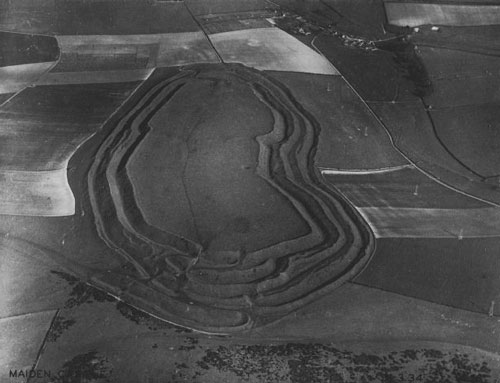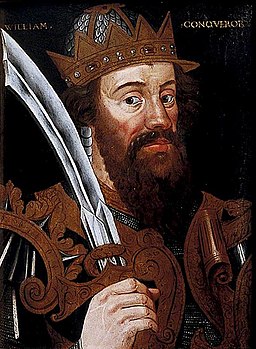England
Many thousands of years ago, in pre-history, England was part of mainland Europe. It was connected by a land bridge, Doggerland, that was covered by water thus forming the English Channel approximately 11,000 years ago. It is hard to say exactly when man first came to the lands that were to become the British Isles, but it can be said with certainty that Paleolithic tribes were flourishing there by 8,000 BC.[1]
Contents |
Stonehenge and other Stone Circles
Around 4,500 BC, the people living in the area that would become the British Isles, emerged from the Paleolithic and into what we now call the Neolithic era. They began building fairly advanced houses out of stone, wood, and whalebone. Additionally, they practiced agriculture and domesticated animals. Though most still lived individually, some began to gather into small villages.
During the early and middle Neolithic stone structures known as "henges" began to appear around the landscape. These structures apparently served many purposes, such as, observing the night sky to determine when to sow and harvest, they were meeting places for the trading of goods and they were used as defensive structures. The most famous example of these, of course, is Stonehenge; although it is definitely not the largest.
Around the time that Stonehenge was built, society moved into the Bronze Age, using bronze to make tools and gold to make jewelry. Trade was steadily increasing: the tin needed to make bronze came almost solely from Cornwall, and the gold from Wales. Products made from these metals were even traded in mainland Europe.[2]
The Celts
Iron working had already begun elsewhere, such as in the Hittite Empire of Asia Minor. However, it was a closely guarded secret and did not come to the British Isles until the Hallstatt people, another iron working tribe, branched there and became the Celts. Just as the earlier inhabitants had their henges, the Celts also had characteristic structures; their hill forts dot the landscape of the British Isles to this day.
The Romans
The Romans first arrived in Britain in 55 BC during one of the expeditions of Julius Caesar during the Gallic Wars. They returned in 43 AD, but this time under the leadership of Emperor Claudius. They brought with them 40,000 troops and gained a firm foothold in only three months. Within 40 years, they had conquered most of Britain and remained there for nearly 400 years. The only areas never under Roman control were the highlands and moorlands of Scotland and Wales, but due to the infertile soil and harsh landscape of these regions, it is possible that the Romans had no desire to settle there.[6]
The Roman Empire's hold on Britain began to fail in 383 AD, when Magnus Maximus, a Roman military commander of Britain took his army to mainland Europe, dethroned the Emperor of the West for a brief spell before he was killed by Emperor Theodosius. With his departure, the Romans did not have the military strength in Britain needed to defend it and withdrew. By the early 5th century, very few Romans remained in Britain.
The Dark Ages
After Britain was abandoned by the Romans, it sank into what is known as the Dark Ages. So-called because of the near-total lack of written records from this period. Much of the history from this period is pieced together from the few written records, the gaps were filled in with speculation, legend, and induction.
By 410, England had been divided into three self-governing parts; the north, which was a mixture of Britons and Angles (a Germanic tribe), the west, which was also mostly Briton and Angle, but with some Irish as well, and the southeast, which was inhabited mostly by Angles.
The Britons faced constant attacks from the Picts and Scots to the northwest, and from the Angles, Saxons (another Germanic race) and Jutes (Danes and Normans) to the southeast. Written records talk about the "conquest of Britain by the Saxons," but there are clues that much of this is an exaggeration on the part of the historians of the time and that the Saxons did not actually forcibly evict the other races to the extent that records claim. Regardless, what is known is that during this period, the Saxons settled all over the area that would one day become England, and became known as the Anglo-Saxons as they lost their connections with their German counterparts. It was around this time that the legendary King Arthur is thought to have lived.
Early on in the Anglo-Saxon era, St. Augustine was sent by the Roman Catholic Church to convert the pagan English to Christianity. He was fairly successful on his mission, as he converted a great number of people. Though excellent as a missionary, he lacked in law and administration, so for the first while religion was a chaotic, disorganized affair. Within a couple of centuries, however, the church moved in, in full force; it was to become and remain the most influential force in English society until the advent of Protestantism.
The Vikings
During this period, England was faced with a number of assaults from a variety of sources, mostly the Vikings of Denmark. All were repelled. However, on one occasion, the Vikings actually managed to move through about half on England, burning and pillaging as they went, but even this attack was eventually turned back. In the end, the Anglo-Saxons remained in control of England, though many Scandinavian settlements remained and were absorbed, and many marks of Scandinavian culture remain in England to this day.
In fact, the Danes became so involved in English politics that in the end, England was ruled for a time by Danish Kings, the last of whom was King Hardacnut. His successor, King Alfred set the stage for the next stage of English history by marrying Emma of Normandy. This allowed the Normans (people of originally Viking origin, who had been living in France for nearly a century at this point and who had converted to Christianity) to enter English culture and politics. Alfred's son and successor, Edward, came to the throne upon his father's death. He remained childless, and had to choose a successor when he realized that his own death was imminent. He wanted Duke William of Normandy to succeed him and left Harold Godwinson (Harold II) as regent until William could come to England to receive the crown.
William the Conqueror
Upon Edward's death, however, Harold took the throne for himself. There was little William could do, as the English were resentful of the Normans, to begin with, and supported Harold completely. William refused to accept this and invaded England in 1066 (The battle of Hastings) with an army of Norman knights. He ruthlessly conquered the whole country, seized the throne, and ruled with an iron fist until his death in 1087. It was the beginning of a new dynasty; the aristocracy was now largely Norman, and England's ties lay with France, rather than Scandinavia.
William's biggest contribution, at least from a historical standpoint, was the Domesday Book. It intended to provide the king with every penny that was rightfully his in taxes. It was a complete listing of every land-owner and exactly what land and animals he owned. The book names 13,000 places in England, most of which had never been mentioned in a written document before. Though in many ways a testimony of William's greed, it is one of the most valuable historical documents in existence.
Middle Ages
After William's reign, England found itself in what is now known as the Medieval period, or Middle Ages, during which hereditary surnames began to be adopted by the English people. Lasting for many centuries, they were a time of constant political shifts. It was rare for a monarch to be succeeded by another who shared his views, so with every successive king, the whole system changed. Many nobles who had assisted the previous king were stripped of their titles, exiled or even executed while friends and allies of the new king were granted powerful positions.
The sheer number and complexity of the political struggles that went on during these times, and the interesting tales surrounding many of the Kings Queen's of England are too vast a topic to even begin to cover them here.
The three major changes that took place during the Medieval period were:
- Scotland and Wales were made part of England through political or military means several times, each time regaining their independence through similar means. In the end, however, they both joined the United Kingdom, of which they are a part today.
- There was a shift of power from the monarchy to the nobles. The king was still the most powerful person in the country, but he could no longer stand on his own against the nobles; if the nobles united behind a cause, there was little the king could do about it. This eventually led to some semblance of a democracy and a Parliament being formed.
- The Roman Catholic Church began to lose power due to a Reformist movement, led by such men as Martin Luther. King Henry VIII, who ruled from 1509-1547, is one of history's most colourful figures. By 1528, Henry had decided he wanted to divorce Catharine of Aragon, who had not born him a son and whose only living child was Mary Tudor, and marry Anne Boleyn, but the Pope Clement VII would not allow it. In 1532, Henry broke with Rome, charged the whole body of the Catholic clergy with treason, and declared himself 'protector and supreme head of the church and clergy of England. 'The number of Protestants grew, eventually removing all power from the Roman Catholic Church in England. Several attempts were made to reinstate Catholicism, most notably by Bloody Mary (Queen Mary Tudor) who slaughtered countless Protestants during her infamous reign. Despite all such efforts, however, England remained a Protestant country. Eventually, religious equality was instated in England, and Catholics were allowed to hold positions of power again, alongside Protestants; however, England is still 80% Protestant.
See Also
- England - The Early Years
- The Normans
- Norman Conquest
- The Cornish People
- Oliver Cromwell and the Civil War
- Anglo-Saxons
- Britons
- Hundred Years War
- Bayeaux Tapestry
- Norman Conquest
- Family Seat
- Domesday Book
References
- ^ Cunliffe, Barry. Britain Begins. Oxford University Press, 2013.
- ^ Young, Christopher; Chadburn, Amanda; Bedu, Isabelle. Stonehenge World Heritage Site Management Plan, 2009.
- ^ "File:Stonehenge2007 07 30.jpg." Wikimedia Commons, the free media repository. 12 Mar 2020, 19:48 UTC. https://commons.wikimedia.org/w/index.php?title=File:Stonehenge2007_07_30.jpg&oldid=403702991
- ^ "File:Maiden Castle from the air, 1934.jpg." Wikimedia Commons, the free media repository. 26 Sep 2019, 20:23 UTC. https://commons.wikimedia.org/w/index.php?title=File:Maiden_Castle_from_the_air,_1934.jpg&oldid=368302880
- ^ "File:William the Conqueror - c. 1580.jpg." Wikimedia Commons, the free media repository. 14 Oct 2017, 11:39 UTC.https://commons.wikimedia.org/w/index.php?title=File:William_the_Conqueror_-_c._1580.jpg&oldid=262845293
- ^ Caesar, Julius. Commentarii de bello Gallico (in Latin), abridged by Cassius Dio, Historia Romana (in Latin).
- ^ Swyrich, Archive materials


